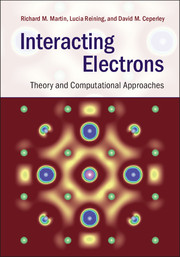Book contents
- Frontmatter
- Dedication
- Contents
- Preface
- Acknowledgments
- Notation
- Part I Interacting electrons: beyond the independent-particle picture
- Part II Foundations of theory for many-body systems
- Part III Many-body Green's function methods
- 9 Many-body perturbation theory: expansion in the interaction
- 10 Many-body perturbation theory via functional derivatives
- 11 The RPA and the GW approximation for the self-energy
- 12 GWA calculations in practice
- 13 GWA calculations: illustrative results
- 14 RPA and beyond: the Bethe–Salpeter equation
- 15 Beyond the GW approximation
- 16 Dynamical mean-field theory
- 17 Beyond the single-site approximation in DMFT
- 18 Solvers for embedded systems
- 19 Characteristic hamiltonians for solids with d and f states
- 20 Examples of calculations for solids with d and f states
- 21 Combining Green's functions approaches: an outlook
- Part IV Stochastic methods
- Part V Appendices
- References
- Index
9 - Many-body perturbation theory: expansion in the interaction
from Part III - Many-body Green's function methods
Published online by Cambridge University Press: 05 June 2016
- Frontmatter
- Dedication
- Contents
- Preface
- Acknowledgments
- Notation
- Part I Interacting electrons: beyond the independent-particle picture
- Part II Foundations of theory for many-body systems
- Part III Many-body Green's function methods
- 9 Many-body perturbation theory: expansion in the interaction
- 10 Many-body perturbation theory via functional derivatives
- 11 The RPA and the GW approximation for the self-energy
- 12 GWA calculations in practice
- 13 GWA calculations: illustrative results
- 14 RPA and beyond: the Bethe–Salpeter equation
- 15 Beyond the GW approximation
- 16 Dynamical mean-field theory
- 17 Beyond the single-site approximation in DMFT
- 18 Solvers for embedded systems
- 19 Characteristic hamiltonians for solids with d and f states
- 20 Examples of calculations for solids with d and f states
- 21 Combining Green's functions approaches: an outlook
- Part IV Stochastic methods
- Part V Appendices
- References
- Index
Summary
We especially need imagination in science.
aria MitchellSummary
The many-body problem consists of two parts: the first is the non-interacting system in a materials-specific external potential; the second is the Coulomb interaction that makes the problem so hard to solve. The most straightforward idea is to use perturbation theory, with the Coulomb interaction as perturbation. This is conceptually simple, but it turns out to be difficult in practice, since the Coulomb interaction is often not small compared with typical energy differences, it is long-ranged and in the thermodynamic limit there is an infinite number of particles, contributing with an infinite number of mutual interaction processes. The present chapter outlines how one can deal with this problem. It contains an overview of facts that one can also find in many standard textbooks on the many-body problem, but that are useful to keep in mind in order to look at later chapters from a sound and well-established perspective.
The many-body problem is a tough one, and it has many facets. Sorting it out is like putting together a huge puzzle. The eight introductory chapters of this book provide pieces of the puzzle, and ideas on what one might do about it. In the present chapter we choose to go in one of the possible directions, in order to arrive at something tangible. The chapter gives the general framework and the main ideas; specific approximations are the topic of Chs. 10–15.
The idea is to start from an independent-particle problem and add the Coulomb interaction as a perturbation. This is not easy: first, the interaction is responsible for a rich variety of phenomena that are completely absent otherwise, such as the finite lifetime of quasiparticles, or additional structures in spectra due to the fact that a quasi-particle excitation may transfer its energy to other elementary excitations, for example plasmons. Second, because of the two-body Coulomb interaction, the problem scales badly with the number of electrons, and straightforward perturbation theory for the many-body hamiltonian with the Coulomb interaction as perturbation rapidly becomes intractable or even useless, especially in large systems.
To get started, Sec. 9.1 recalls why things are not so easy. The following sections try to solve one problem after the other, starting from Sec. 9.2 where the Green's function is reformulated in a way that is appropriate for a perturbation expansion.
- Type
- Chapter
- Information
- Interacting ElectronsTheory and Computational Approaches, pp. 193 - 221Publisher: Cambridge University PressPrint publication year: 2016



